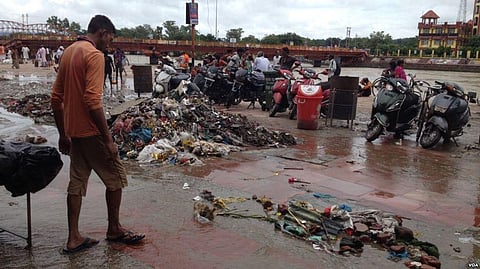
- Home
- न्यूजग्राम
- NewsGram USA
- India
- World
- Politics
- Entertainment
- Culture
- Lifestyle
- Economy
- Sports
- Sp. Coverage
- Misc.
- NewsGram Exclusive
- Jobs / Internships

Haridwar, Sep 13, 2017: On a gray monsoon morning, Darshana Kapoor picks her way gingerly through the slush on the riverbank after taking a dip in the Ganges River in Haridwar town, one of the most revered spots for Hindus.
But the ritual bath that Hindus believe absolves a lifetime of sins was not an uplifting experience for her. "My faith brought me here, but when I see the garbage floating in the river, I felt so bad. I had to scrub myself," she said.
Haridwar, India
She was not exaggerating. The Central Pollution Control Board has said that the water of the Ganges at Haridwar is not fit for bathing.
The murky condition of the mighty Ganges is a letdown for thousands of devotees who flock daily to the pilgrim town, some for a ritual dip, some to immerse the ashes of their loved ones or to take part in a colorful prayer ceremony held every evening to celebrate the Ganges, which devotees call "Maa" or mother.
These devotees were hoping to see results from a flagship $3 billion initiative launched by Prime Minister Narendra Modi to revive the river, particularly in Hinduism's holiest towns such as Haridwar and Varanasi.
The pristine waters of the river as it gushes down the Himalayas have long turned into a toxic sludge due to garbage, untreated sewage and industrial waste dumped into it as it courses through booming pilgrim and industrial towns along the vast, populous plains of North India. It is a huge concern because the river is a water source for some 400 million people.
After his victory in 2014, Modi had acknowledged the failure of an expensive three-decade long effort to rejuvenate the Ganges, and vowed to succeed where his predecessors did not.
But three years after the Hindu nationalist leader's pledge, the once-mighty river is still dying, say environmental activists.
{"type":"video","tracklist":true,"tracknumbers":true,"images":true,"artists":true,"tracks":[{"src":"https://www.newsgram.com/wp-content/uploads/2017/09/e3dbf826-0bdb-4474-bb8b-992c34321f6e.mp4","type":"video/mp4","title":"Indian Devotees Wait for Clean Ganges","caption":"Indian Devotees Wait for Clean Gangesn","description":"","meta":{"length_formatted":"1:00"},"dimensions":{"original":{"width":640,"height":360},"resized":{"width":674,"height":379}},"image":{"src":"https://www.newsgram.com/wp-includes/images/media/video.png","width":48,"height":64},"thumb":{"src":"https://www.newsgram.com/wp-includes/images/media/video.png","width":48,"height":64}}]}
India's top environmental court, the National Green Tribunal, slammed the government in July, saying "the status of river Ganga has not improved in terms of quality and it continues to be a serious environmental issue."
The court prohibited dumping waste within 500 meters of the river and said that no development should be allowed within 100 meters of the river as it flows along a 500-kilometer stretch from Haridwar to the town of Unnao.
That is crucial to revive not just the river, but also the banks or "ghats" in pilgrim towns where visitors throng.
However, in a country with abysmally poor enforcement, environmentalists point out court orders do not always translate into action on the ground.
"The basic problem in this country and this case also is compliance," says M.C. Mehta, an environmentalist who has been leading a campaign to get rid of the pollution. "No monitoring mechanism is there, so it is very difficult to say how much directions have been complied with."
The main challenge is the slow pace of setting up treatment plants – about three-quarters of the sewage generated in the towns and cities in the northern plains flows untreated into the Ganges.
Sewage treatment plants in Haridwar, for example, can only cope with half the sewage. New ones have been planned, but none have been built yet.
In fact, some fear the river is becoming dirtier as India's growing population and economic boom has meant an ever growing influx into towns like Haridwar.
Ganesh Singh owns a shop at the famed "Har ki Pauri," the most revered spot along the riverbank where people gather to attend the evening prayer, where the poor line up for free meals offered by devotees and where pavement sellers hawk flowers.
He said there have been efforts to educate the people about not dumping waste into the river. "Many polythene bags, bottles, garbage used to be thrown into the river earlier. It is better now," he said, gazing at the river, happy that it helps draw in more tourists who bring more business.
However just a few meters down from his shop, piles of rubbish dumped along the riverbank are getting slowly washed into the water with the rain.
That is why Mehta remains skeptical and worries the political will for the gigantic task is missing. "I am not talking about this leadership – it is for the last 32 years the same thing is going on," he said. "It should not be just lip service that we are the sons and daughters of mother Ganga, without doing something."
In a signal that he is aware the Ganges cleanup is flagging, Modi this month handed charge of the campaign to a senior cabinet minister, Nitin Gadkari, who has a reputation for getting the job done.
Devotees and environmentalists are hoping that will happen. (VOA)
